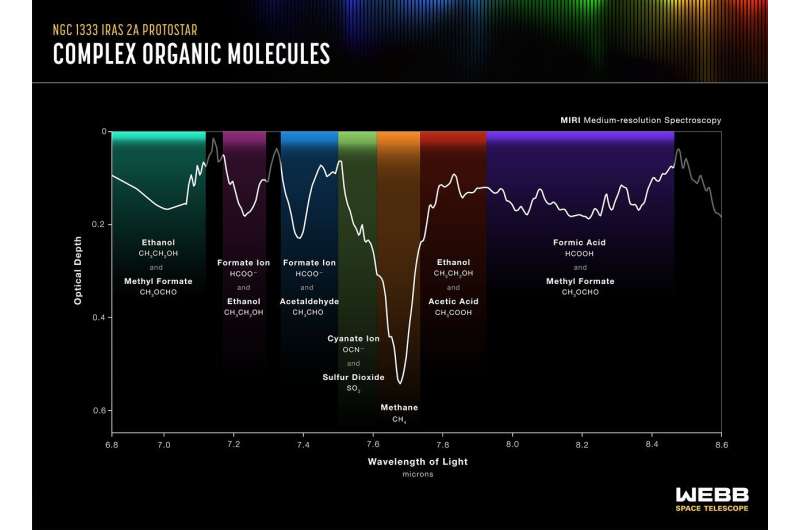An international team of astronomers using the NASA/ESA/CSA James Webb Space Telescope have discovered a variety of molecules, ranging from relatively simple ones like methane to complex compounds like acetic acid and ethanol, in early-stage protostars where planets have not yet formed. These are key ingredients for making potentially habitable worlds.
The presence of complex organic molecules (COMs) in the solid phase in protostars was first predicted decades ago from laboratory experiments, and tentative detections of these molecules have been made by other space telescopes. This includes Webb’s Early Release Science Ice Age program, which discovered diverse ices in the darkest, coldest regions of a molecular cloud measured to date.
Now, with the unprecedented spectral resolution and sensitivity of Webb’s Mid-InfraRed Instrument (MIRI), as part of the JOYS+ (James Webb Observations of Young ProtoStars) program, these COMs have been individually identified and confirmed to be present in the interstellar ices. This includes the robust detection of acetaldehyde, ethanol (what we call alcohol), methyl formate, and likely acetic acid (the acid in vinegar), in the solid phase.
“This finding contributes to one of the long-standing questions in astrochemistry,” said team leader Will Rocha of Leiden University in the Netherlands. “What is the origin of COMs in space? Are they made in the gas phase or in ices? The detection of COMs in ices suggests that solid-phase chemical reactions on the surfaces of cold dust grains can build complex kinds of molecules.”
As several COMs, including those detected in the solid phase in this research, were previously detected in the warm gas phase, it is now believed that they originate from the sublimation of ices. Sublimation is to change directly from a solid to a gas without becoming a liquid. Therefore, detecting COMs in ices makes astronomers hopeful about developing an improved understanding of the origins of other even larger molecules in space.

Harold Linnartz led the Laboratory for Astrophysics in Leiden over many years and coordinated the measurements of the data used in the study published in Astronomy & Astrophysics. Ewine van Dishoeck of Leiden University, one of the coordinators of the JOYS+ program, shared, “Harold was particularly happy that in the COM assignments lab work could play an important role as it has been a long time getting here.”
Scientists are also keen to explore to what extent these COMs are transported to planets at much later stages in the evolution of the protostar. COMs in ices are transported more efficiently into planet-forming disks than gas from clouds. These icy COMs can therefore be inherited by comets and asteroids which in turn may collide with planets in formation. In that scenario COMs can be delivered to those planets, potentially providing the ingredients for life to flourish.
The science team also detected simpler molecules, including methane, formic acid (which makes the sting of ants painful), sulfur dioxide, and formaldehyde. Sulfur dioxide in particular allows the team to investigate the sulfur budget available in protostars. In addition, it is of prebiotic interest because existing research suggests that sulfur-containing compounds played an important role in driving metabolic reactions on the primitive Earth. Negative ions were also detected; they form part of salts that are crucial for developing further chemical complexity at higher temperatures. This indicates that the ices may be much more complex and require further research.
Of particular interest is that one of the sources investigated, IRAS 2A, is characterized as a low-mass protostar. IRAS 2A may therefore have similarities with the primordial stages of our own solar system. If that is the case, the chemical species identified in this source were likely present in the first stages of development of our solar system and were later delivered to the primitive Earth.
All of these molecules can become part of comets and asteroids and eventually new planetary systems when the icy material is transported inward to the planet-forming disks as the protostellar system evolves,” said van Dishoeck. “We look forward to following this astrochemical trail step by step with more Webb data in the coming years.”
Other recent work by Pooneh Nazari of Leiden Observatory, posted to the arXiv preprint server, also raises astronomers’ hopes for finding more complexity in ices, following the tentative detections of methyl cyanide and ethyl cyanide from Webb NIRSpec data. Nazari says, “It is impressive how Webb now allows us to further probe the ice chemistry down to the level of cyanides, important ingredients in prebiotic chemistry.”
More information:
W. R. M. Rocha et al, JWST Observations of Young protoStars (JOYS+): Detecting icy complex organic molecules and ions, Astronomy & Astrophysics (2024). DOI: 10.1051/0004-6361/202348427
P. Nazari et al, Hunt for complex cyanides in protostellar ices with JWST: Tentative detection of CH3CN and C2H5CN, arXiv (2024). DOI: 10.48550/arxiv.2401.07901
Provided by
European Space Agency
Citation:
Webb finds ethanol and other icy ingredients for new worlds (2024, March 13)
retrieved 13 March 2024
from
This document is subject to copyright. Apart from any fair dealing for the purpose of private study or research, no
part may be reproduced without the written permission. The content is provided for information purposes only.